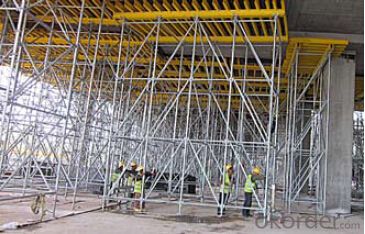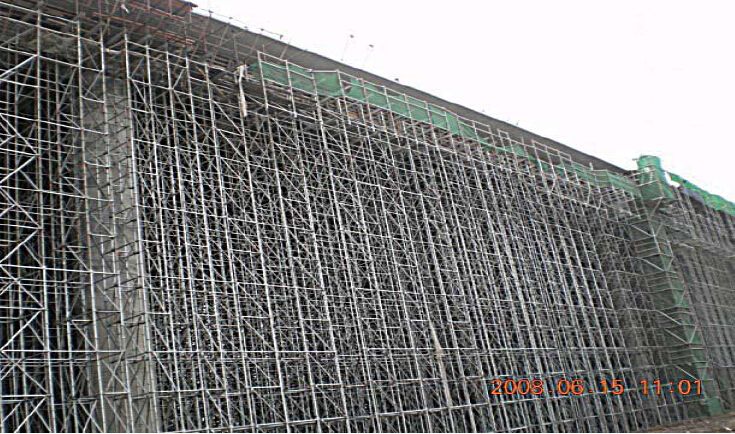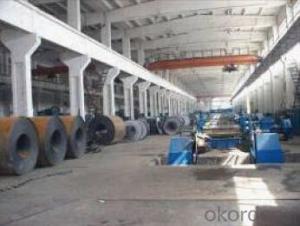Tower scaffolding for formwork and scaffolding system
- Loading Port:
- Tianjin
- Payment Terms:
- TT OR LC
- Min Order Qty:
- 50 m²
- Supply Capability:
- 1000 m²/month
OKorder Service Pledge
Quality Product, Order Online Tracking, Timely Delivery
OKorder Financial Service
Credit Rating, Credit Services, Credit Purchasing
You Might Also Like
Tower Scaffolding
Shoring tower is an effective supporting system. It is easy to assemble and dismantlement, and
has excellent stability and bearing capacity. It has been widely used in the construction of industry
& residential buildings , bridges, tunnels and dam project, etc.
Characteristics:
◆ High degree of standardization.
◆ Easy storage and transportation
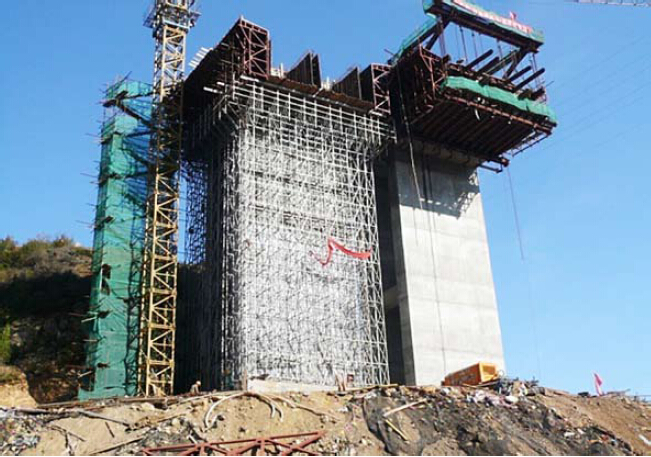
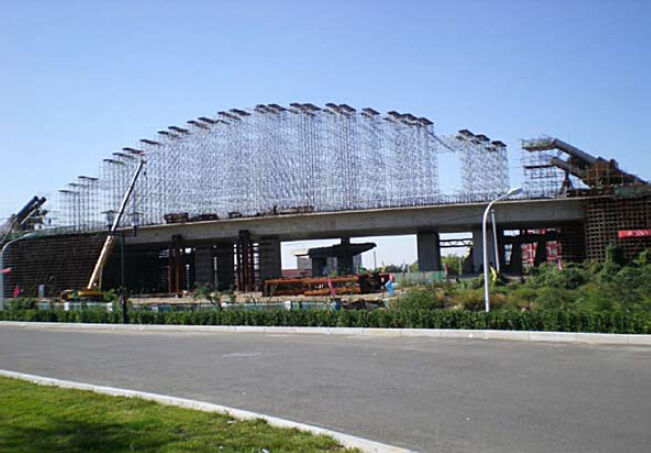
- Q: What are the common design considerations for steel formwork in high-rise construction?
- Some common design considerations for steel formwork in high-rise construction include the structural stability and load-bearing capacity of the formwork system, ease of assembly and disassembly, durability and resistance to wear and tear, ability to withstand high concrete pressures, flexibility for various architectural layouts, and safety features such as guardrails and access platforms. Additionally, factors like material cost, availability, and environmental impact may also be taken into account during the design process.
- Q: How does steel formwork handle different concrete strength requirements?
- Steel formwork proves to be a highly versatile and durable solution, capable of effectively managing a wide range of concrete strength demands. Concrete strength is influenced by its mixture proportions, curing conditions, and the quality of materials employed. By providing a reliable and secure framework for pouring concrete, steel formwork plays a pivotal role in fulfilling these requirements. One notable advantage of steel formwork lies in its ability to withstand the immense pressures and strong vibrations encountered during concrete pouring and compaction. This becomes particularly crucial when dealing with high-strength concrete, as it necessitates greater force application to attain the desired density and durability. Thanks to its structural integrity and rigidity, steel formwork can bear these forces without deformations or failures, consequently ensuring a consistent and uniform distribution of the concrete. Another key benefit of steel formwork is its flexibility in terms of shape and size, allowing for customization to accommodate diverse concrete strength specifications. This versatility facilitates the construction of various structural elements, including columns, beams, walls, and slabs, each with unique strength requirements. Additionally, steel formwork can be effortlessly assembled and disassembled, making it adaptable to different projects and enabling the reuse of formwork components. Moreover, steel formwork imparts a smooth and precise finish to the concrete surface, a crucial factor in achieving desired aesthetics and functionality. This is particularly important for architectural or decorative concrete, where a high-quality finish is imperative. The smooth and flat surface provided by steel formwork ensures even curing of the concrete and minimizes the risk of surface defects. To summarize, steel formwork is well-suited to handle diverse concrete strength requirements due to its robustness, durability, adaptability, and ability to deliver a smooth finish. Its strength and flexibility make it an ideal choice for construction projects demanding varying concrete strengths, guaranteeing the successful execution of diverse structural designs and meeting performance expectations.
- Q: What are the cost implications of using steel formwork?
- The cost implications of using steel formwork can vary depending on various factors. Initially, the upfront cost of using steel formwork can be higher compared to traditional formwork options such as wood or plywood. Steel formwork requires a higher initial investment as it is more expensive to purchase and maintain. However, it is important to consider the long-term benefits and cost savings that steel formwork can offer. One major advantage of steel formwork is its durability and reusability. Unlike wood or plywood, steel formwork can withstand multiple uses without significant wear and tear. This means that it can be used for a longer period of time, resulting in cost savings over multiple projects. Additionally, steel formwork requires less maintenance and repair compared to other formwork options, reducing ongoing expenses. Another cost implication of using steel formwork is the potential for increased labor productivity. Steel formwork is generally easier to assemble and disassemble, leading to faster construction cycles. This can result in reduced labor costs and increased efficiency, ultimately saving money on construction projects. Furthermore, steel formwork offers better quality control and accuracy in concrete placement. It ensures consistent dimensions and shapes, reducing the need for rework and minimizing material waste. This can lead to cost savings by optimizing the use of concrete and reducing the need for additional materials. Lastly, the cost implications of using steel formwork should also consider the overall project timeline. Due to its strength and stability, steel formwork can support faster construction schedules, allowing for earlier project completion. This can result in potential cost savings by reducing financing and overhead costs associated with longer construction durations. In summary, while the initial cost of steel formwork may be higher, the long-term benefits such as durability, reusability, labor productivity, quality control, and project timeline optimization can outweigh these initial expenses. Therefore, the cost implications of using steel formwork should be evaluated in the context of the specific project requirements and long-term cost savings.
- Q: Can steel formwork be used for bridge piers?
- Yes, steel formwork can be used for bridge piers. Steel formwork is a versatile and durable option that is suitable for constructing various types of structures, including bridge piers. It offers numerous advantages such as high strength, ease of assembly and disassembly, and flexibility in design. Steel formwork allows for precise shaping and reinforcement of the bridge piers, ensuring structural integrity and stability. Additionally, steel formwork can withstand the high loads and pressures exerted by the bridge piers during their lifespan. Therefore, steel formwork is a reliable and commonly used choice for constructing bridge piers.
- Q: How does steel formwork contribute to the overall stability of a structure?
- Steel formwork is a crucial component in the construction industry that greatly contributes to the overall stability of a structure. It is widely used in the casting of concrete elements such as walls, slabs, columns, and beams. One of the primary ways that steel formwork enhances stability is by providing a rigid and robust framework for the pouring and setting of concrete. The steel panels and frames are designed to withstand the pressure exerted by the wet concrete, ensuring that it retains its shape and does not deform during the curing process. This helps to prevent any potential structural deficiencies or unevenness that may compromise the stability of the final structure. Furthermore, steel formwork offers exceptional strength and durability, making it suitable for various construction projects. The high tensile strength of steel allows it to withstand heavy loads, which is particularly important in the construction of large-scale structures with significant weight-bearing requirements. This strength also ensures that the formwork can be reused multiple times, reducing the overall construction costs and environmental impact. Additionally, steel formwork provides excellent dimensional stability, meaning it maintains its shape and dimensions throughout the construction process. This characteristic is crucial in ensuring the accuracy and consistency of the structure, as any deviations or variations in shape may result in structural instability. Moreover, steel formwork is highly resistant to moisture and other environmental factors, which can be detrimental to the stability of a structure. Its corrosion-resistant properties make it suitable for use in outdoor construction sites, where exposure to rain, humidity, and other elements may occur. This resistance to corrosion ensures that the formwork remains intact and does not weaken over time, thereby contributing to the long-term stability of the structure. In conclusion, steel formwork plays a vital role in enhancing the overall stability of a structure. Its rigid and robust framework, combined with its strength, durability, dimensional stability, and resistance to environmental factors, ensures that the concrete is properly formed and retains its structural integrity. By providing a stable and secure foundation for the construction process, steel formwork significantly contributes to the stability and safety of the final structure.
- Q: How is steel formwork removed after concrete has cured?
- Steel formwork is typically removed after the concrete has cured by following a systematic process. Firstly, any props or supports that were used during the pouring and curing of the concrete are removed. These supports are usually adjustable and can be easily disassembled. Next, the formwork panels are carefully inspected to ensure that the concrete has fully cured and is ready for removal. Once this is confirmed, the formwork panels are detached from each other starting from the top and working downwards. To remove the formwork, the connections between the panels are usually released using specialized tools such as formwork wedges or clamps. These connections are typically designed to be easily disassembled, allowing for efficient removal. After disconnecting the panels, they are lifted away from the cured concrete. This process is often done using cranes, forklifts, or other lifting equipment, depending on the size and weight of the formwork panels. Care must be taken during the removal process to avoid any damage to the concrete structure. The formwork panels are carefully lifted, ensuring that they do not scrape or impact the concrete surface. Additionally, any residue or debris that may have accumulated on the formwork panels during the curing process should be removed before lifting them away. Once the steel formwork has been completely removed, it can be stored for future use or dismantled for recycling. Proper storage and maintenance of formwork are crucial to ensure its longevity and cost-effectiveness for future construction projects. In conclusion, the removal of steel formwork after concrete has cured requires a systematic approach that involves the careful disassembly and lifting of the formwork panels. Following these steps ensures the integrity of the concrete structure while allowing for the reuse or recycling of the formwork.
- Q: How does steel formwork handle different concrete curing temperatures?
- Steel formwork is a highly durable and versatile construction material that is well-suited to handle different concrete curing temperatures. The key advantage of steel formwork is its ability to withstand high temperatures without deformation or structural damage. Concrete curing temperatures can vary depending on several factors, such as the climate, project specifications, and construction schedule. Steel formwork is designed to withstand these variations and maintain its structural integrity throughout the curing process. In instances where the concrete curing temperature is high, steel formwork effectively dissipates the heat due to its excellent thermal conductivity. This helps to prevent excessive heat buildup, which could potentially lead to premature curing or thermal cracking of the concrete. The steel formwork acts as a heat sink, absorbing and distributing the heat evenly, ensuring uniform curing throughout the concrete structure. On the other hand, steel formwork also performs well in low-temperature curing conditions. Its high tensile strength and rigidity allow it to withstand the pressure exerted by the cold concrete mix during the curing process. This prevents any distortion or deformation of the formwork, ensuring accurate and precise shaping of the concrete structure. Furthermore, steel formwork is also resistant to moisture and humidity, which are critical factors in curing concrete. It does not absorb water or release moisture, maintaining a consistent moisture content in the concrete during the curing process. This is particularly advantageous in areas with high humidity or where the curing time is extended. Overall, steel formwork is a reliable and robust material that can effectively handle different concrete curing temperatures. Its ability to dissipate heat, withstand cold temperatures, and resist moisture makes it a preferred choice for construction projects where temperature variations are a concern.
- Q: Are there any specific design considerations for steel formwork construction?
- Yes, there are several specific design considerations for steel formwork construction. Firstly, the formwork should be designed to withstand the weight of the concrete and the pressure exerted during pouring. It should be structurally strong and rigid to prevent any deformation or collapse. Additionally, the formwork design should allow for easy installation, dismantling, and reusability, as steel formwork is often used in repetitive construction projects. Special attention should be given to the joints and connections to ensure stability and prevent leakage. Finally, proper surface finish and alignment should be considered to achieve the desired concrete finish.
- Q: What are the different types of edge protection systems used in steel formwork?
- There are several types of edge protection systems that are commonly used in steel formwork to ensure the safety of workers and prevent accidents. These systems are designed to provide a secure barrier along the edges of the formwork, preventing falls and providing support for workers. Some of the different types of edge protection systems used in steel formwork include: 1. Handrails: Handrails are one of the most common types of edge protection systems used in steel formwork. They consist of a horizontal bar that is placed at a certain height along the edge of the formwork to provide a stable support for workers. Handrails are typically made of steel or other durable materials and are designed to withstand heavy loads and provide a secure grip for workers. 2. Toeboards: Toeboards are another type of edge protection system used in steel formwork. They are placed along the lower edge of the formwork to prevent objects or materials from falling off and causing accidents. Toeboards are typically made of steel or other sturdy materials and are designed to withstand impact and provide a solid barrier. 3. Mesh barriers: Mesh barriers are frequently used as edge protection systems in steel formwork. They consist of a flexible mesh that is attached to the formwork to create a barrier that prevents falls and provides a visual warning for workers. Mesh barriers are typically made of high-strength materials such as steel wire or polypropylene and are designed to be durable and resistant to impact. 4. Safety nets: Safety nets are another type of edge protection system used in steel formwork. They are typically suspended below the formwork to catch workers or objects in case of a fall. Safety nets are made of strong and flexible materials and are designed to absorb the impact of a fall and prevent serious injuries. 5. Guardrails: Guardrails are commonly used as edge protection systems in steel formwork. They consist of a vertical post and a horizontal rail that are placed along the edges of the formwork to provide a solid barrier. Guardrails are typically made of steel or other strong materials and are designed to withstand heavy loads and provide a secure barrier for workers. Overall, the different types of edge protection systems used in steel formwork are designed to provide a safe working environment for workers and prevent accidents. These systems play a crucial role in ensuring the safety and well-being of workers in construction sites.
- Q: How does steel formwork affect the overall construction timeline?
- Steel formwork can significantly impact the overall construction timeline by expediting the process. Its durability and reusability allow for faster assembly and dismantling, reducing the time required for formwork installation and removal. Additionally, steel formwork provides a smoother surface finish, minimizing the need for additional plastering or rendering work, further saving time during the construction phase.
Send your message to us
Tower scaffolding for formwork and scaffolding system
- Loading Port:
- Tianjin
- Payment Terms:
- TT OR LC
- Min Order Qty:
- 50 m²
- Supply Capability:
- 1000 m²/month
OKorder Service Pledge
Quality Product, Order Online Tracking, Timely Delivery
OKorder Financial Service
Credit Rating, Credit Services, Credit Purchasing
Similar products
Hot products
Hot Searches
Related keywords


